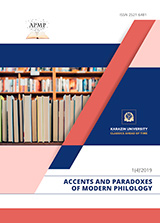The Russian Army of Nicholas І, Seen by the British during the Russian-Turkish War of 1853-1856 (Linguoimagological Aspect)
Abstract
The article analyzes the views of the British soldiers, officers and journalists on their opponents – the Russians during the Russian-Turkish war of 1853-1856 from the perspective of linguoimagology. This science considers the means of image verbalization. For the study the memoirs of the Crimean War witnesses, journalists’ notes, letters of the English soldiers and officers home were selected. The assessment, given to the enemy by the British, is of particular interest. The following aspects are explored: the Russians in battle, cunning behavior of Nicholas I army soldiers, their ammunition. The British writers also drew attention to the color of the officers' uniforms (blue) and highlighted the color of the soldiers (gray), which was different from the red one, used in England. The authors emphasize the unsatisfactory state of the ordinary soldiers’ clothing (low assessment) and the excellent condition of the elite troops (high assessment). In addition, the English writers paid attention to the beards of the Russians, which were not already widespread in Europe at that period of time, but were considered as a sign of holiness in Russia, and were worn both by nobles and people of the lower strata. The authors of the memoirs use the following means of interpreting the linguoimagological aspect: inversion, metaphor, exclamation marks, superlatives, lexical repetitions, stereotypes, details, and even French borrowings. Aesthetic and ethical assessments are used to add expressiveness to the narrative.
Downloads
References
Арнольд, И. (2005). Стилистика. Современный английский язык. Москва: Флинта: Наука. 384 с.
Виноградов, В. (1991). Британский лев на Босфоре. Москва: Наука. 160 c.
Гумбольдт, В. (1960). О различии строения человеческих языков и его влиянии на духовное развитие человеческого рода. Москва: Прогресс. С. 68–86.
Иванова, Л. (2012). Имагология как новое направление в лингвистике. Киев: Издательский Дом Дмитрия Бураго. С. 73-76.
Иванова, Л. (2014). Рецепция Франции в лингвоимагологическом аспекте. Киев: Издательский Дом Дмитрия Бураго. С. 91-100.
Иванова, Л. (2015). Синтез науки – архитектуры – религии как предмет лингвоимагологичного описания (на материале публицистики Н. В. Гоголя). Спб.: Мир русского слова № 1. С. 52–57.
Иванова, Л. (2015). Синтез наук и искусств как важная тенденция развития современного сознания. Київ : Вид-во НПУ ім. М. П. Драгоманова, 2015. Вип. 8. С. 164–171.
Иванова, Л. (2016) Жанровые основания лингвоимагологического анализа. Саратов: Саратовский Национальный исследовательский государственный университет им. Н. Г. Чернышевского. С. 148-155.
Иванова, Л. (2016). Русский Берлин в лингвоимагологическом аспекте. Киев: Издательский Дом Дмитрия Бураго. 112 с.
Иванова, Л. (2016). Французские города в видении Д. И. Фонвизина-путешественника. Київ: Вид-во НПУ ім. М. П. Драгоманова. С. 177-183.
Іщенко, Н. (2008). Міфотворчість у воєнному дискурсі: національний міф про Кримську війну 1853-1856 років у літературі Великої Британії другої половини ХІХ століття. Сімферополь: Тавр. Нац. ун-т ім. В. І. Вернадського. 426 с.
Карпенко-Иванова, У. (2006). Фрейм «Вооруженное противостояние» в русской, английской, итальянской культурно-языковой традиции. Киев: Издательский Дом Дмитрия Бураго. 232 с.
Малахов, В. (1997). «Война культур», или интеллектуалы на границах. Москва: Октябрь. № 7.
Милославская, С. (2012). Русский язык как иностранный в истории становления европейского образа России. Москва: ФЛИНТА: Наука. 400 с.
Рябов, О. (2003). Нация и гендер в визуальных репрезентациях военной пропаганды. Retrieved from: http://ivanovo.ac.ru/alumni/olegria/Nation2.htm
Сабитова, З. (2014). Языковая картина мира: языковые свидетельства вживания народа в природу. Москва: ФЛИНТА: Наука, 2014. С. 370–380.
Тупчий, А. В. (2018). Образ Англии в русском языковом сознании конца XVI – первой половины XIX вв.: лингвоимагологический аспект: дис. … канд. филол. наук: 10.02.02 – русский язык. Киев: 282 с.
Aho, J. (1994). This thing of darkness: a sociology of the enemy. Seattle: Univ. of Washington Press. 189 p.
Brackenburry, G. (1855). The Campaign in the Crimea. An historical sketch, accompanied by forty one double tinted Plates from drawings taken on the spot by William Simpson. 2nd series. London: P. & D. Colnaghi & Co. and Longman, Brown, Green and Longmans. 136 p.
Collins English dictionary. (1991). 3-d ed. Glasgow: Harper Collins Publishers. 1791 p.
Harle, V. (2000). The enemy with a thousand faces: The tradition of the Other in Western political thought and history. Westport, Conn.: Praeger. 232 p.
Hosking, G. (1997). Russia: people and empire, 1552-1917. Cambridge, Massachusetts: Harvard University Press. 548 p.
Keen, S. (1986). Faces of the enemy: reflections of the hostile imagination. San Francisco: Harper and Row. 292 p.
Oxford Advanced Encyclopedic Dictionary. (1992). Oxford: Oxford University Press. 1081 p.
Royer, A. (1854). The English Prisoners in Russia. London: Chapman and Hall. 543 p.
Russell, W. (1857). Complete history of the Russian War, from its commencement to its close: giving a graphic picture of the great drama of war / by Russell, correspondent of the London Times. Toronto, C. W.: Bostwick & Barnard. 181 p.
Sun-tzu. The Art of War. Retrieved from: http://classics.mit.edu/Tzu/artwar.html




